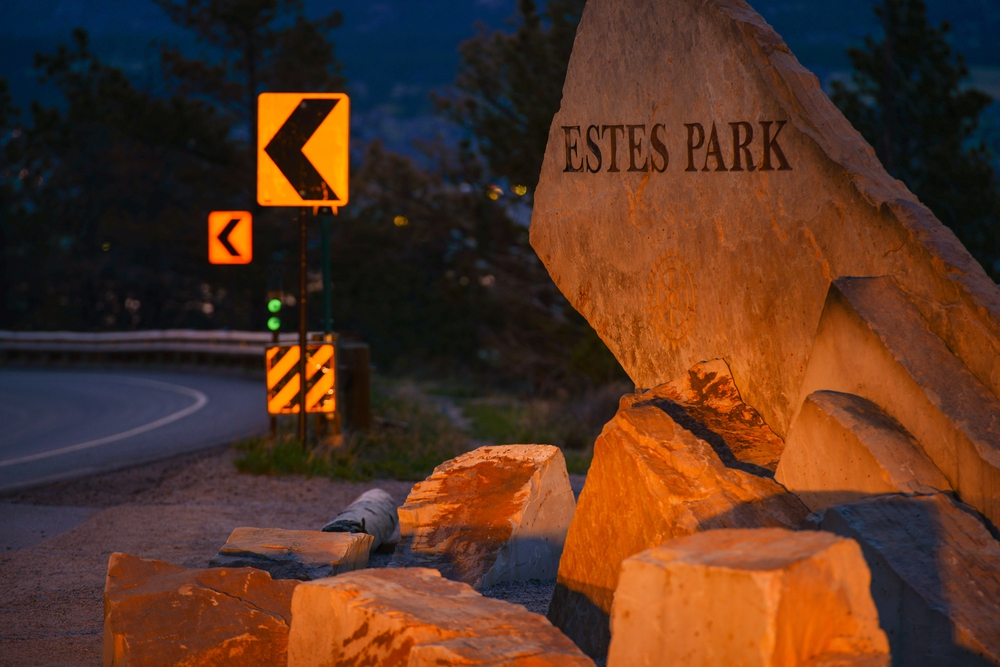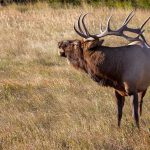Estes Park and Denver are both places in the state of Colorado, located approximately 65 to 129 km apart depending on what route is driven.
Known as The Mile High City, Denver combines the outdoors with urban sophistication. The surrounding mountains and national parks are easily accessible, while the heart of the city is alive with music, art, and culture.
Estes Park is known as the base camp for the Rocky Mountain National Park. Sitting at an elevation of almost 7600 feet, the mountainous village boasts picturesque views as well as a plethora of outdoor adventure activities such as hiking, rock climbing, white water rafting, and more.
If you’re planning a trip to Estes Park and Denver, this article will give you important information to help decide your itinerary. The article will discuss:
- The 3 best routes from Denver to Estes Park
- Things to see and do along the way
- Public transportation options from Denver to Estes Park.
Let’s get started!
The Best Routes from Denver to Estes Park
There are 3 main routes from Denver to Estes Park: The US-36 West Route, the CO-7 North Route or Peak to Peak Highway, and the I-25 to CO-66 to US-36 Route. Each route has its own positives and negatives which will be discussed below.
Regardless of which route you eventually choose, the Colorado Department of Transportation urges drivers to always check road updates before embarking on a trip. Leaving Denver in peak traffic will increase congestion and travel time. It’s a good idea to leave early to get ahead of traffic.
US-36 Route West
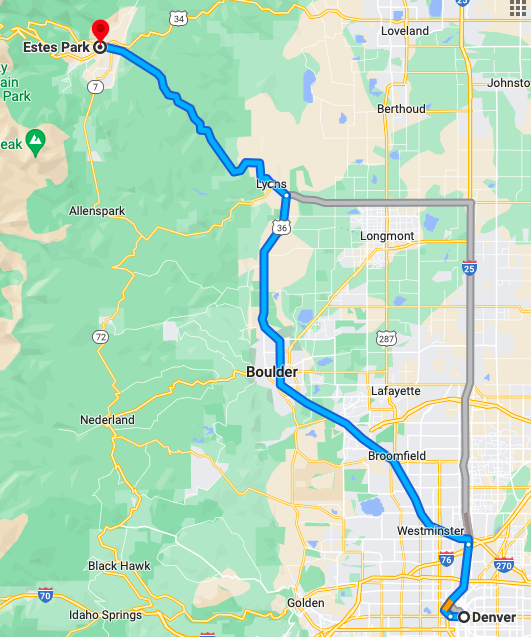
The US-36 Route is the fastest way to get to Estes Park from Denver. It heads North West out of the city, passing through the city of Boulder and Lyon before heading straight to Estes Park.
This route takes around 1 hour and 30 minutes and is 65 miles in total. It has a low elevation compared to the CO-7 route so is least likely to be affected by winter conditions – a positive if you are traveling at this time!
However, it is also the most likely to be affected by heavy traffic, which will significantly increase overall travel time.
As the US-36 is the main route from Denver to Estes Park (and on through the Rocky Mountains National Park), it can get busy! Congestion at peak travel times should be expected.
Depending on what time you travel through Boulder, there may be heavy traffic as well. There’s usually a lot of congestion in downtown Boulder due both to tourism and people commuting to work, so try to avoid driving through in the morning or the evening.
I-25 North to CO-66 West to US-36 West Route
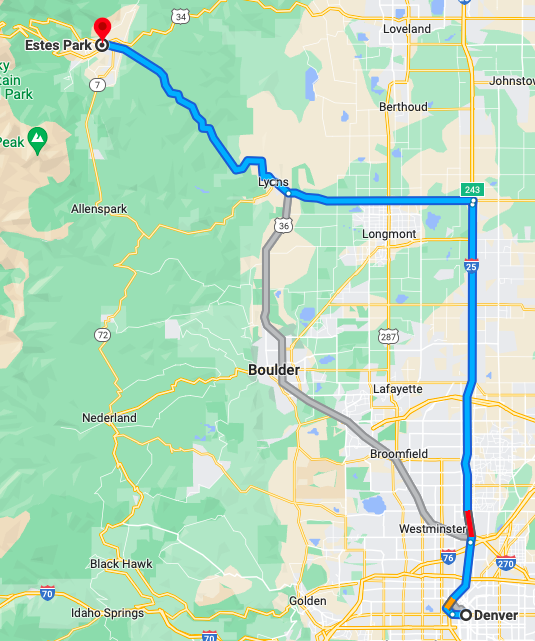
Taking the I-25 North and CO-66 West is a way to get to Lyon and onto Estes Park without having to drive through Boulder1
This could be beneficial if you are traveling at peak traffic hours for Boulder and want to avoid congestion.
This route is similar to the US-36, taking 1 hour and 33 minutes over 65 miles in minimal traffic.
One negative to this route is that it will miss out on a few interesting attractions in Boulder. However, if you just want to get to Estes Park quickly, then this is the route for you!
Scenic Route via CO-7 North
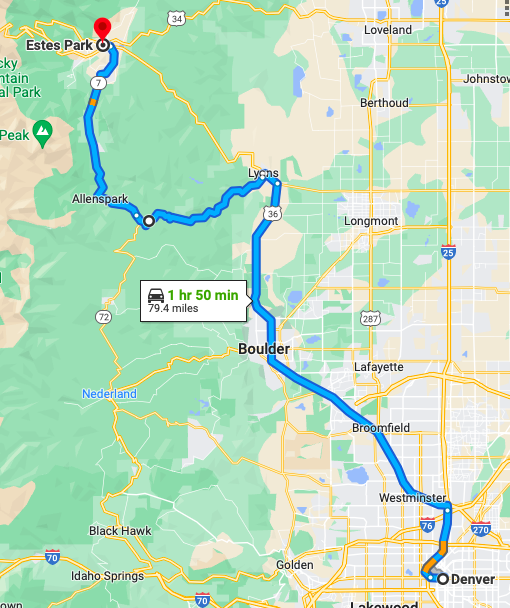
The CO-7 North to Estes Park from Denver will take around 1 hour and 50 minutes over a distance of 80 miles. This route is quite scenic and gets you out of the urban landscapes and into the wilderness.
Heading out of Denver on the US-36, pass through Boulder and join the CO-7 at Lyon to head through South St. Vrain Canyon1
Alternatively, you can take the I25 North out of Denver, then the CO-66 to Lyon before joining the CO-7. This would add on about 10 minutes depending on traffic.
Landslides can occur in the South St. Vrain Canyon, and the road was closed for a time in June 2023 because of this. Remember to check road updates so you don’t get turned around!
Another negative to this route is the major plan to develop the CO-7 by 2040. Significant road works and increased congestion are to be expected.
Things to See and Do Along the Way to Estes Park
There are many things to see and do on your journey to Estes Park from Denver, and they vary depending on which route you take. Below is a short description of some interesting attractions along all three routes:
1. Flatirons Vista Trailhead
40 minutes out of Denver sits the iconic Flatiron rock formations. These slanted sandstone landmarks are integral to Boulder’s sense of place and are often common on logos or pictures.
Pull off the US-36 at Broomfield and head west to the Flatiron Vista trailhead, which is a 2.7-mile round trip that takes about 2 hours.
It’s a challenging trail, with a steep 450 elevation gain. However, you will be rewarded with fantastic views of Rocky Mountain National Park once you reach the top – so it’s definitely worth the climb!
It’s also possible to climb up these 300 million-year-old rock formations, so if you’re a climber then this is definitely a spot to research! Note that the Flatirons are closed to climbers from February to July each year to protect nesting raptors.
2. Boulder’s Pearl Street Mall
Do you have some holiday money that needs spending? Pearl Street Mall is the perfect place! Located in the Boulder city center, the mall holds over 1,000 different businesses that are almost all locally owned.
Pearl Street Mall is pedestrian-only, so you can freely wander through the streets shopping, eating, or watching many of the street performers that frequent the mall.
A stand-out shop is the Boulder Book Store, established in 1973. This bookshop spans three stories, so you’re sure to find a book that tickles your fancy!
Serving customers for over 46 years, Pearl Street Mall is a great place to stop off on your way to Estes Park from Denver.
3. Celestial Seasonings Tea Factory (Boulder)
Another popular tourist attraction as you drive through Boulder is the Celestial Seasonings Tea Factory.
A popular tea brand in the US, Celestial Teas runs factory tours where you can learn their tea-making process, sample some of their best teas, and shop for a box yourself. The tour is 45 minutes and costs $5 per person.
It’s perfect to add a bit of spice to your trip!
4. Chautauqua Park
When making your way to Estes Park, you’ll often hear many people recommend Chautauqua Park as the perfect start to your trip.
And they’re absolutely right — this iconic, historic location is a great location to begin your journey!
Located on the outskirts of Boulder, this breathtaking park features Colorado sights you won’t find anywhere else. Jagged peaks frame the background as trees and greenery sprawl as far as the eye can see.
For a park so close to the city, it’s a shame if you can’t pay a visit during your trip to Estes Park!
To reach this wilderness pitstop from Denver, take either the CO-93 North (if you’re coming from the mountains) or the US-36 West – whichever is more convenient.
Don’t forget a camera, a few minutes of rest, and snacks to munch on while enjoying the view!
5. NCAR (National Centre for Atmospheric Research) Mesa Laboratory
The National Centre for Atmospheric Research Mesa Laboratory is located in Boulder. If anything science-related is of interest to you, definitely check this place out!
The Visitors Centre contains a multitude of interactive exhibits on earth systems, weather, and climate change. The NCAR Mesa Laboratory is open 7 days a week, and you can even take a public tour around the lab!
6. Oskar Blues Grill & Brew (Lyons)
Approximately 50 minutes’ drive from Denver and you’ll find yourself in Lyon. Here, you can either take the CO-7 or continue on the US-36 onward to Estes Park. But before you do, check out Oskar Blues Grill & Brew!
Opened in 1997 by founder Dale Katechis, Oskar Blues has been serving classic pub food with a twist for over 25 years. The food is fresh, unique, and delicious.
Stop in for lunch on your way through – you won’t regret it!
7. Planet Bluegrass (Lyons)
Planet Bluegrass is a beautiful ranch that sits just outside Lyon that is well known for being a popular music festival venue.
Founded in 1988, Planet Bluegrass focuses on ‘sustainable festivation’ and is a place where people who love music and the planet come to create a community. It’s a certified B Corp organization with a Leave No Trace ethic.
They hold 3 annual festivals; Telluride Bluegrass, RockyGrass, and Rocky Mountain Folks Festival. This year marks 50 years of the Telluride Bluegrass, which brings over 11,000 people together every summer solstice.
Check the calendar – there might just be a festival around the time you are traveling through! Even if there isn’t, it’s still worth going to check out the area as the views are breathtaking.
8. Hall Ranch Open Space (near Lyons)
Lying just to the west of Lyons are the rolling hills of Hall Ranch Open Space. This 3,900-acre ranch contains some awesome trails – all of which can be hiked, and most can be used by bikes and horses!
The longest trail is 4.7 miles, but you can add on distance by doing some of the other loops as well.
There are great views to be seen and exotic sandstone buttes to explore, so stop off to stretch your legs before continuing the final 30 minutes to Estes Park!
Note that there are controlled burns happening until October 31st in Hall Ranch Open Space, so check the website before going to make sure the trails are open.
9. Chapel on the Rock
CO-7 might be better known for the natural sights, dramatic terrain, and Colorado wildlife to see along the way, but there’s one must-visit gem hiding between Allenspark and Estes Park as well: the Chapel on the Rock!
Built in 1916, this Catholic church looks like a scene straight out of a movie.
The building is made of stone with imposing windows atop boulders, giving it an impression of something that’s sculpted from the surroundings.
There’s also a small pond nearby where visitors can stretch their legs, admire the scenery, and take snapshots of what are probably the best views in the area!
And if you’d like to participate in the religious mass, make sure to drop by every Friday at 8:30 in the morning. The church itself is open to visitors between 10 AM and 4 PM, so feel free to explore!
10. Lily Lake
If the Chapel on the Rock is high on your must-visit places en route to Estes Park, you may as well add the Lily Lake to your list!
This mountain lake reflects the same tranquility that blankets the CO-7 road, so it’s the perfect place to breathe nature in and immerse yourself in the area’s overall calm energy.
Raring to sneak physical activity into the trip? Bring your hiking shoes with you and walk the 0.8-mile loop skirting the banks of the lake! This will give you a 360-degree view of the lake’s natural beauty.
Just know that this one’s quite popular, so you’ll always have company! Feel free to join fellow visitors to fish, hike, watch the wildlife.
Public Transportation Options
There is no direct public transport from Denver to Estes Park. However, you can use a couple of different services to get there. Firstly, there’s the Flatiron Flyer, which is a rapid bus transit service that gets you from Denver to Boulder.
The FF1 leaves Union Station and takes the US-36 to Boulder. It runs every 15 minutes during peak hours, and every 30 minutes during non-peak. The trip will take around 40 minutes.
From Boulder, you’ll then have to take another two buses with a self-transfer to reach Estes Park. The second part of this trip will take approximately 2 hours and 43 minutes.
Between May 27th and October 1st, there are four departures a week: two on a Saturday at 0734 hours and 0834 hours, and then another two on a Sunday at 0712 hours and 0812 hours. There are no buses that run during the week!
In terms of cost, the first bus with the Regional Transportation District costs anywhere between $1 and $9, and the second bus with the company Bustang costs anywhere between $8 and $54. Happy travels!

